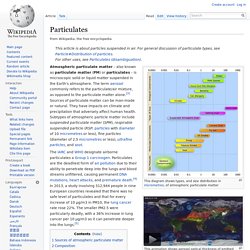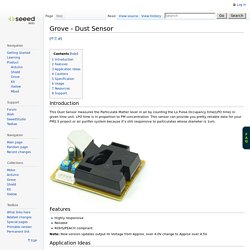

Revisions for 'DustDuino' What is it?

DustDuino can help individuals with limited resources monitor PM10 and PM2.5 concentrations, indoors or outdoors. It uses Shinyei PPD42NS, a $15USD optical sensor that uses an LED and a lens to determine the concentration of dust in a partially closed chamber that draws in air from its surroundings. The sensor data is received by an Arduino development board and transmitted to Xively. Prototypes of DustDuino have been successfully built and used in various indoor and outdoor locations. [question:dustduino] Test Results Test results indicate that DustDuino provides accurate and useful information, albeit of a somewhat limited scope and under certain conditions. There are still some unknowns with regard to the sensor - for example, whether it needs to be co-located with higher-quality instruments for calibration, and whether it could be used in extreme environments. Photos Why make one?
How to Make One From the DustDuino Research Note. Particulates. This diagram shows types, and size distribution in micrometres, of atmospheric particulate matter This animation shows aerosol optical thickness of emitted and transported key tropospheric aerosols from 17 August 2006 to 10 April 2007, from a 10 km resolution GEOS-5 "nature run" using the GOCART model.[1][2] (click for more detail) * green: black and organic carbon * red/orange: dust * white: sulfates * blue: sea salt Movie map of distribution of aerosol particles, based on data from the Moderate Resolution Imaging Spectroradiometer (MODIS) on NASA’s Terra satellite. * Green areas show aerosol plumes dominated by larger particles. * Red areas show aerosol plumes dominated by small particles. * Yellow areas show where large and small aerosol particles are mixing. * Gray shows where the sensor did not collect data.

Atmospheric particulate matter – also known as particulate matter (PM) or particulates – is microscopic solid or liquid matter suspended in the Earth's atmosphere. Standalone: Sharp Dust Sensor ← Arduino Tutorials. We based our work on the excellent post over here but contrary to the author, we did not try out multiple sensors and we are using an Arduino Fio. In this tutorial, we’ll focus on how to get your Sharp Optical Dust Sensor to work and what to watch out for. In addition, we will try to provide European shop references and prices in € where possible. Components Arduino Fio (BoxTec) – ~21.57 €FTDI Basic Breakout 3.3V (BoxTec) – ~14.52 €Sharp Optical Dust Sensor (Robotshop) #GP2Y1010AU0F – 10.75 € – Datasheet6-pin TE 1.5mm pitch connector cable (DigiKey) #A100196-ND – 1.2 €220 uF Capacitor150 Ω ResistorBreadboardM/M jumper cables Setup Prerequisites Able to upload sketches via the Arduino IDE to your Arduino In the figure below you can see the overall setup using an Arduino Fio and the Sharp Dust sensor using a classical Breadboard.
Even though you may use an Xbee shield to load your sketches wirelessly, we use a FTDI breakout board here to connect to our PC. Pin numbering on the Sensor Code. Sharp Dust Sensor and Arduino. Sharp’s GP2Y1010AU0F is an optical air quality sensor, designed to sense dust particles.

An infrared emitting diode and a phototransistor are diagonally arranged into this device, to allow it to detect the reflected light of dust in air. It is especially effective in detecting very fine particles like cigarette smoke, and is commonly used in air purifier systems. The sensor has a very low current consumption (20mA max, 11mA typical), and can be powered with up to 7VDC. The output of the sensor is an analog voltage proportional to the measured dust density, with a sensitivity of 0.5V/0.1mg/m3. This is how the optical dust sensor works: According to the GP2Y1010AU0F data sheet, all 6 pins on sensor need to be connected to Arduino: Do not miss the 150ohm resistor and a 220uF capacitor: The LED pin has to be modulated with a cycle of 1ms as discussed in the datasheet. Ok, you should now have every thing connected: The Arduino source code:
Grove - Dust Sensor. The Mental Munition Factory: Measure air pollution in your home or backyard with a DustDuino. This week, the World Health Organization (WHO) took a major step by announcing that air pollution is carcinogenic to humans.

WHO also announced they are considering particulate matter, a major component of indoor and outdoor air pollution, as carcinogenic to humans as well. The International Agency for Research on Cancer (IARC), a special unit inside WHO tasked with promoting international collaborations on cancer research, reached that conclusion after reviewing more than 1000 scientific papers on the carcinogenicity of air pollutants. Air pollution and particulate matter will be included in IARC's Monograph, which is an encyclopedia of known carcinogens. Particulate matter will be classified as a Group 1 carcinogen, along with tobacco smoke and asbestos. In an IARC press release [1], the Deputy Head of the Monographs Programme, Dr. This finding elevates the urgency to clean up the air, both outdoors and indoors. Dust Sensor. [中文] Introduction This Dust Sensor measures the Particulate Matter level in air by counting the Lo Pulse Occupancy time(LPO time) in given time unit.

LPO time is in proportion to PM concentration. This sensor can provide you pretty reliable data for your PM2.5 project or air purifier system because it's still responsive to particulates whose diameter is 1um. Features Highly responsive Reliable ROHS/PEACH compliant Note: New version updates output Hi Voltage from Approx. over 4.0V change to Approx over 4.5V. Application Ideas Cautions Please keep it upright. 3 min preheat time is required when used at the first time. Specification Usage. Air Quality Test Box.